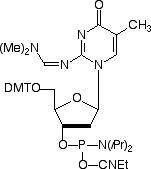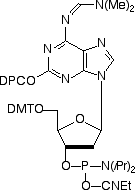Glen Report 20.15: Technical Brief - New application of 5-Me-iso-dC and iso-dG
In a paper published in the November 2007 issue of Biotechniques1, researchers from the Siemens Medical Solutions Diagnostic Lab in Berkeley provided an interesting new way to solve the problem of designing degenerate primers and/or probes in PCR situations in which, for instance, equivalent quantification across subtype samples is desired.


In the paper under reference, the authors showed that the iso-bases, 5-Me-iso-dC (F) and iso-dG (J) (our products 10-1065 and 10-1078, respectively) can actually be used as kind of universal bases. In the example described in the paper, they developed probes binding to a region of HCV transcripts containing 2 genotype-specific polymorphic sites. And they showed that degenerate probes containing iso-bases provide much closer cycle thresholds (CtS) for targets of both genotypes than other approaches aimed at creating degenerate probes.
It is already well established that iso-bases can increase specificity of nucleic acid hydridization when introduced as a third base pair. Now these authors have demonstrated that iso-bases 5-Me-iso-dC and iso-dG performed as degenerate pyrimidine and purine bases, respectively. Iso-dG further functioned as a degenerate base opposite B (C, T, and G) ambiguous sites.
Iso-bases are supplied under license from EraGen Biosciences, Inc. US Patents 5,432,272, 6,001,983, 6,037,120, and 6,140,496.
Reference
- 1. M. Abraham, Maria Albalos, Toumy Guettouche, Michel J. Friesenhahn, and T. Battersby, Biotechniques, 2007, 43, 617-624.
Product Information
dmf-5-Me-isodC-CE Phosphoramidite (10-1065)
dmf-isodG-CE Phosphoramidite (10-1078)
- Glen Report 20.11: An Unnatural Base Pair System for the Expansion of Genetic Information
- Glen Report 20.12: Thiophosphoramidites and Their Use in Synthesizing Oligonucleotide Phosphorodithioate Linkages
- Glen Report 20.13: Technical Brief - Purification of 6-FAM Labelled oligos using Glen-Pak™ Cartridges
- Glen Report 20.14: More Click Chemistry
- Glen Report 20.15: Technical Brief - New application of 5-Me-iso-dC and iso-dG
- Glen Report 20.16: Technical Brief - New application for 5’-OMe-dT phosphoramidite
- Glen Report 20.17: New Product - Deuterated 2’-Deoxyguanosine Phosphoramidite
- Glen Report 20.18: New Products - Solid CPR II / Formylindole – Aldehyde Modifier
- Glen Report 20.19:New Product - 5'-Cholesteryl-TEG Phosphoramidite
- Glen Report 20.110: Improving Universal Support II for Oligonucleotide Synthesis
- Glen Report 20.111: Differences Between Universal Support II and III
- Glen Report 20.112: Technical Brief - Phage Display, Artificial Antibodies and Trimer Phosphoramidites

